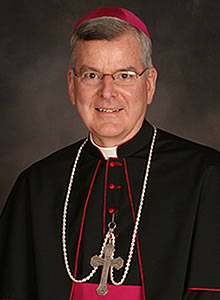
Last Sunday evening, I offered the first of a monthly holy hour at the University of St. Thomas campus for college-age men and women. I was so pleased with the 200 some students who attended. It was a wonderful experience!
The method of prayer that we used is called “lectio divina” or the sacred reading of Scripture, which is really an ancient form of monastic prayer in the church.
Worthwhile idea
My inspiration for holding such prayer sessions was an article I read in America magazine some six years ago. A high school teacher at Georgetown Prep in Washington, D.C., wrote an article entitled, “Can High School Students Pray?”
He insightfully observed that we teach young people how to say their prayers, but do we really teach them how to pray? He asked some of his students to gather for the 14th Annotation of St. Ignatius’ Exercises. After the fact, he reported that they indeed showed great interest in, and aptitude for, prayer.
Encouraged by that teacher’s success, I invited some young men from Cathedral High School in New Ulm to join me and one other priest for prayer one Sunday a month during the school year. We used the “lectio divina” format, as it is the method of prayer I use. We gathered from 6 to 7 p.m., with a popcorn, pizza and Mountain Dew reception afterward. They were all on their way home by 8 p.m.
Simple format
Each month a different member of the group selected the Scripture passage to be used and led us through the process.
The format is quite simple:
» The leader begins with a prayer to focus and calm us down.
» The leader reads the Scripture passage through the first time slowly and reverently. Everyone is attentive to any word, phrase or image that strikes him. (St. Benedict says that one listens to the word with the ears of one’s heart.)
» The leader pauses, then reads the passage again.
» After the second reading the leader stops and asks if there are any questions with the text, anything that’s not clear or not understood.
» The leader reads the passage a third time. Again, each one focuses on the word, phrase or image which stands out.
» All go separately to a quiet place to “ruminate” for 20 minutes or so, over his word, phrase or image and its meaning.
This “rumination” can lead to meditation (how does this passage speak to my life), or to contemplation (resting with the Lord in that word) or “oratio” (expressing a prayer of praise, thanksgiving or petition). Then one writes down his reflections.
» The group reassembles and each person has a chance to share his reflections. (No one is ever asked to share if he prefers not to do so.)
» The leader concludes with a summary prayer of praise and/or thanksgiving.
It is quite a simple process, but the joy lies in the fact that it really works! I have been quite impressed with the depth of some of the reflections offered.
Start your own group
Now, one does not have to be a bishop to begin such a prayer group. I encourage any parish priest to do so on a parish or deanery level. I do suggest limiting the number of the group to 8 to 10 so that everyone has an opportunity to share.
My hope is that this prayer becomes a daily routine for each participant. Because all of Scripture is inspired, any passage may be selected. If God wishes to communicate with us (and he does), he will use any passage of the Bible to speak to our hearts.
I encourage you to try “lectio divina” as one proven method of prayer. And may you be blessed in doing so.



